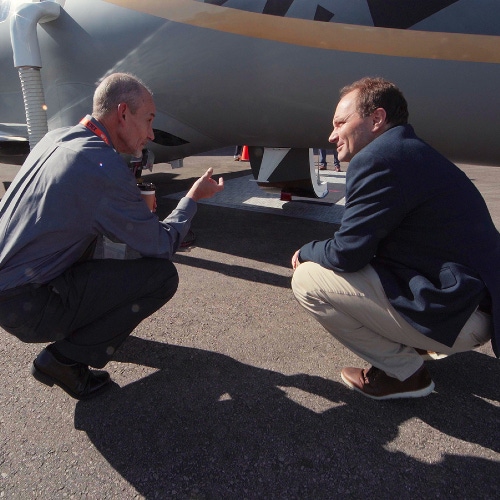
A new venue has opened in the 5G landscape, and the competition there is hot, heavy and very high.
Incumbent in-flight broadband Internet provider Gogo Business Aviation and SmartSky Networks, an upstart competitor, are racing to build 5G-style networks on the ground to beam speedy Internet connections to business aircraft overhead. Both companies expect to switch on widespread services later this year, after suffering lengthy delays in getting their systems up and running. Moreover, each company has accused the other of infringing on patents, an unsurprising development given that their networks will work in the exact same strip of unlicensed spectrum, the 2.4GHz band.
It is also no surprise that the 5G battle is expanding into the aircraft industry when 5G connections are already making their way from smartphones and into laptops, automobiles, satellites, robots, warehouses and a wide array of other devices and locations.
SmartSky's lengthy launch
SmartSky had hoped to launch its air-to-ground (ATG) network for aircraft connectivity in 2016. Now, roughly six years later, the company touts some commercial operations and some commercial users after a partial network launch late last year. Company officials said the bulk of SmartSky's network buildout – which spans 200 cell towers across the US – will be finished by June.
"We do have commercial customers now," said Brit Wanick, SmartSky's marketing chief.
Figure 1:  SmartSky's Dave Claassen, left, and Colin Campbell of Cambridge Consultants discuss SmartSky's network.
SmartSky's Dave Claassen, left, and Colin Campbell of Cambridge Consultants discuss SmartSky's network.
(Source: Cambridge Consultants)
SmartSky's network actually runs the 4G LTE standard, but Dave Claassen, SmartSky's CTO, explained that it sports some 5G-style enhancements, including beamforming antennas and a virtualized core network. Vendors for the network, which runs exclusively in the 2.4GHz band, include hardware supplier Tektelic and software developer Cambridge Consultants.
As a private startup, SmartSky doesn't disclose spending or revenues and profits, but company officials have suggested it has invested a total of $100 million in developing and deploying its technology.
The result, according to early tests, is a network that can support "multi-gigabytes" of upload and download data consumption per hour, SmartSky's Claassen said. He said that the company doesn't like to provide peak or average data connection speeds because he said such numbers are not indicative of a customer’s experience with an inflight network, especially given the variables involved in beaming Internet connections to high-speed aircraft.
Derek Long, of Cambridge Consultants, explained that SmartSky's network is essentially a bespoke private LTE network for business aircraft. "It's not a standard cellular implementation," he said.
But that private network isn't SmartSky's only strategic push. The company also recently filed a patent-infringement lawsuit against its main rival, Gogo. The lawsuit focuses on four patents covering "beamforming hand-off and beamforming hand-off in the unlicensed band," "horizon-oriented architecture" and "harmonious spectrum reuse" technology, according to SmartSky. The company is asking a judge to block Gogo's network launch, and a ruling is expected sometime this summer.
Gogo's long road
Gogo disputes the patent infringement. "Our patent attorneys and engineers have studied the entire SmartSky patent portfolio, and we know these four patents very well," Gogo's CEO Oakleigh Thorne said during his company's recent quarterly conference call, according to a Seeking Alpha transcript. "I can assure you we do not infringe on those patents. And we will fight this lawsuit with extreme vigor."
It's no surprise that Gogo is familiar with SmartSky's patents. As noted by AIN, Gogo itself two years ago sought unsuccessfully to challenge SmartSky's patents with the US Patent and Trademark Office (USPTO).
Gogo is moving forward with its own ATG network launch, which is based on open RAN 5G technology from vendors including Airspan. Gogo's network will use a 4MHz sliver of licensed spectrum in the 800 MHz band as well as an unlicensed chunk of the 2.4GHz band. The network represents an update to Gogo's existing 3G network.
Gogo had hoped to launch its 5G network in 2021 but delayed rollout due to problems stemming from the global chipset shortage. Now the company is targeting the second half of 2022 to deploy the network. Company officials expect to spend around $50 million this year getting it up and running.
Gogo is also pursuing another strategy to add capacity. During the company's recent quarterly conference call, company officials suggested Gogo would add low Earth orbit (LEO) satellite connectivity to its ATG network.
"For instance, we could partner with a global LEO provider and add capacity," Thorne said, explaining that Gogo has already developed a platform it calls Avance, which can support multiple types of network connectivity onboard aircraft.
"Let's say that in five years we improve ATG to deliver 50 Mbit/s. And in that same timeframe, LEO networks are deployed that can deliver 100 Mbit/s," Thorne said. "If [we] added the LEO network to the existing Avance ATG installation, that configuration would deliver 150 Mbit/s much greater than either the ATG or LEO network to deliver on their own."
Gogo is already selling Avance equipment to its customers and suggested that it wouldn't be difficult to add equipment from a LEO satellite partner.
Related posts:
— Mike Dano, Editorial Director, 5G & Mobile Strategies, Light Reading | @mikeddano
About the Author(s)
You May Also Like












